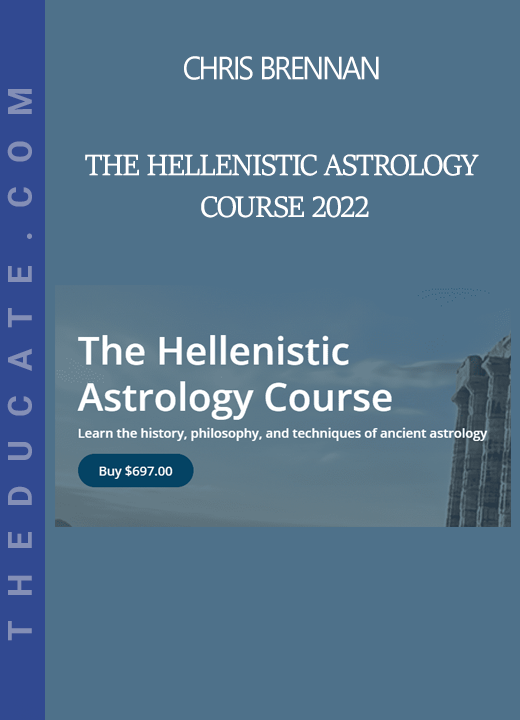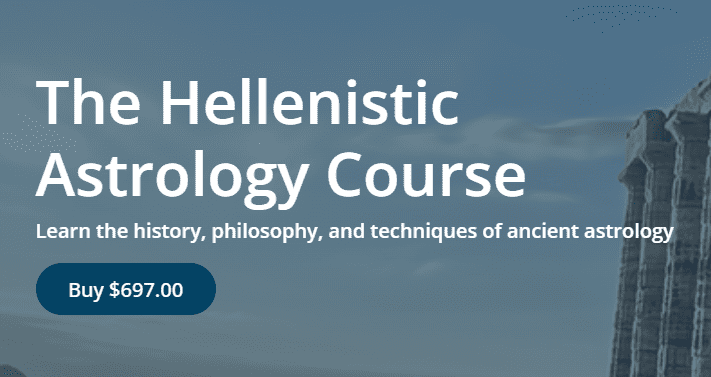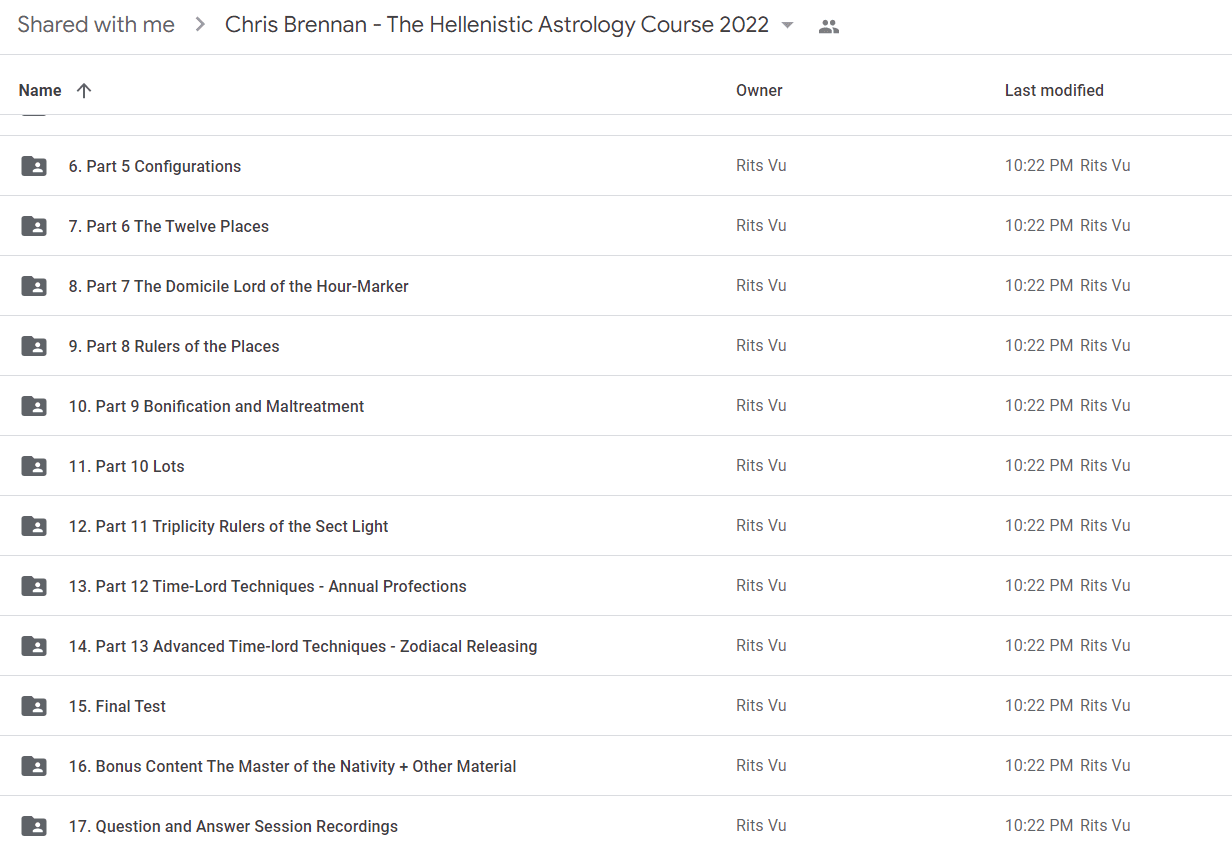Description
Chris Brennan – The Hellenistic Astrology Course 2022
Learn the history, philosophy, and techniques of ancient astrology
About the Hellenistic Astrology Course
Hellenistic astrology is a tradition of astrology that was practiced in the Mediterranean region from the 1st century BC through the 7th century AD, roughly coinciding with the rise and fall of the Roman Empire. It is the original tradition of western astrology, and many of the techniques that are employed by modern western astrologers today originated during the Hellenistic period.
The purpose of the Hellenistic Astrology Course is to learn about where the techniques of western astrology came from, how they were originally used, and how to apply them in practice today.
The course is divided into 13 parts, and provides a detailed overview of the history, philosophy, and techniques of ancient astrology. It is presented entirely online through a private website that each student gains access to upon registering. The majority of the lessons are presented through pre-recorded video lectures, which are complemented by chart examples, diagrams, and other written materials.
The course contains over 100 hours of lectures on basic, intermediate, and advanced techniques, providing a comprehensive overview of the fundamentals of western astrology. The course primarily focuses on natal astrology, and students will finish the course with a strong foundation in how to interpret birth charts in a systematic and effective manner.
The course is taught by Chris Brennan, who is one of the leading authorities on the study and practice of Hellenistic astrology, and is the author of the book Hellenistic Astrology: The Study of Fate and Fortune.
Who is this course for?
The Hellenistic Astrology Course is primarily designed for students and practitioners of modern western astrology who feel like they have gone as far as they can go with that approach, and are looking for something more.
It can also be useful for newer students of astrology who want to build a strong foundation with their studies right from the start, taking them from basic concepts through intermediate and advanced techniques.
Here are some considerations to help determine if the course is right for you:
- If you are looking for a systematic method for interpreting birth charts.
- If you would like to learn how to determine specific information about the nature and course of a person’s life.
- If you want to demystify the process of integrating the different components of a horoscope and learn how to achieve chart synthesis.
- If you are looking for a more accurate and consistent form of astrology that can be used to predict events.
- If you want to know where astrology came from and what its technical and conceptual foundations are.
- Most of all, the course is designed for those who want to become better astrologers, both by teaching you how to utilize the techniques you already know more effectively, as well as by introducing you to new techniques that can do things that you didn’t even know were possible.
What do you get when you sign up for the course?
Here are some of the things that you get access to immediately upon signing up for the course:
- 100+ hours of video lecturesOver 100 hours of video lectures on the history, philosophy, and techniques of ancient astrology. The core material of the course is centered around the lectures, which can be streamed on any device.
- Ancient astrological textsGuided readings of translations of ancient astrological texts, with primers on basic vocabulary and concepts, in order to allow students to read more advanced material on their own.
- Private Discussion ForumAccess to a private Facebook group for students of the course, where you can ask questions and discuss concepts with other students. This provides ongoing community support, even once you have completed the course.
- Downloadable DiagramsDozens of downloadable and printable diagrams and tables in PDF format, which help to memorize and explicate different technical concepts.
- Hundreds of chart examplesThe lectures in the second half of the course employ hundreds of birth chart examples, so that you can learn both the theory as well as the practice underlying the techniques, and see how they apply in real life.
- Live Monthly Q&A SessionEach month students of the course can attend a live question and answer session with Chris over Zoom. The recording is posted on the course site after, for those who can’t make the live meeting.
- Certificate of CompletionA certificate of completion once you finish the course and complete the final test, which is a written test that you receive feedback on.
- Bonus ContentThe list of benefits for students of the course expands periodically, as new lectures and other bonus materials are continually added.
Synopsis of Each Part of the Course
Below you will find a brief synopsis of what is covered during each of the 13 parts of the course. You can also scroll down to the bottom of this page in order to see some of the different files that are available in the course, and how it is structured.
Part 1: The History of Hellenistic Astrology
The first part of the course provides a broad overview of the history of ancient astrology. In it we explore some of the historical undercurrents which fostered the development of Hellenistic astrology in Greco-Roman Egypt, and how developments in the earlier Mesopotamian and Egyptian astrological traditions led to the introduction of some of the basic technical doctrines, such as the zodiac and the twelve houses. Other topics covered include the mysterious origins of Hellenistic astrology, astrologers whose texts survived from this period, mystery schools present in the early tradition, and an overview of the ongoing efforts to recover the ancient traditions in modern times.
Part 2: The Philosophy of Hellenistic Astrology
The purpose of the second part of the course is to become familiar with the philosophical undercurrents that played a role in the development and practice of Hellenistic astrology. In particular we focus on debates surrounding the mechanism underlying astrology, as well as debates about fate and free-will, and the extent to which things were viewed as predetermined. This part of the course also features coverage of some of the major philosophical schools during this time period and their relationship with astrology, such as Platonism, Aristotelianism, Stoicism, Hermeticism, Neoplatonism, Gnosticism, and Skepticism.
Part 3: Basic Techniques and Concepts: Planets
In the third part of the course we begin a four-part series on the basic technical doctrines of Hellenistic astrology, with an overview of the ancient approach to dealing with the planets, signs, aspects, and houses. This part of the course sets a foundation for a more precise approach to predictive astrology by introducing a number of basic interpretive principles and distinctions that are either missing from or are not entirely clear in modern astrology. In the section on the planets we deal with concepts such as benefic & malefic, sect, gender, the significations of the planets, and more.
Part 4: Basic Techniques and Concepts: Signs of the Zodiac
In the fourth part of the course we continue our series on basic concepts by focusing on the meaning of the twelve signs of the zodiac. In this part of the course we deal with concepts such as planetary rulerships, gender, triplicity, quadruplicity, precession, and more.
Part 5: Basic Techniques and Concepts: Aspects or Configurations
In the fifth part of the course we continue our series on basic concepts by focusing on the doctrine of aspects or configurations. In this part of the course we cover concepts such as right versus left sided aspects, overcoming versus hurling rays, the quality of the different aspects, and more.
Part 6: Basic Techniques and Concepts: The Twelve Houses or Places
In the fifth part of the course we complete our series on basic concepts by focusing on the doctrine of the twelve places, which are known as “houses” in modern astrology.
In this segment we talk about the origins of the concept of houses, different forms of house division, the rationale for the meanings of the houses, planetary joys, and lots more.
Part 7: The Domicile Lord of the Hour-Marker
In the seventh part of the course you’ll learn how to use the ruler of the Ascendant or “Hour-Marker” in order to determine information about the focus and life direction of the native. This part of the course includes a review of the original conceptualization of the significations of each of the twelve houses.
Part 8: Rulers of the Twelve Places
In the eighth part of the course you will learn how to interpret the rulers of the twelve houses or “places” when they are in houses other than their own. For example, what it means when the ruler of the 7th is in the 10th, or when the ruler of the 11th is in the 9th, and so on.
Part 9: Conditions of Bonification and Maltreatment
In this part of the course you will learn about a special set of considerations for determining planetary condition, known as the conditions of bonification and maltreatment. These 7 conditions allow you to determine how a planet is functioning in a chart, and whether its significations are being affirmed and enhanced, or denied and corrupted.
Part 10: The Lots or “Arabic Parts”
The purpose of the tenth part of the course is to introduce the technical concept known as Lots (kleroi), which are known in modern times as “Arabic Parts.” Lots are mathematical points that are used in a chart in order to study specific topics in a person’s life, and oftentimes they can be the key to understanding things that are otherwise unclear about a person’s life. In particular we will focus on the Lot of Fortune, and discuss the rationale for its calculation, as well as its meaning and uses in chart delineations.
Part 11: Triplicity Rulers of the Sect Light
In the eleventh part of the course you will learn about the concept of rulership by trigon or triplicity, and I will show you how it is used within the context of a specific technique for determining the overall foundation of the nativity known as the triplicity rulers of the sect light. We will also introduce some of our first timing techniques, which are timing the activation of certain placements through planetary periods and ascensional times.
Part 12: Time-Lord Techniques: Annual Profections
The purpose of the twelfth part of the course is to introduce the concept of time-lord techniques, and to focus on one technique in particular known as Annual Profections.
The premise of the Hellenistic time-lord techniques is that not all placements in a given natal chart are operating at their fullest potential at any given moment in time. Instead, there are specific periods in a native’s life when certain planets or sectors in the chart become activated, thus drawing out the latent potential of those natal placements.
Annual Profections are used in order to determine which planets will be activated in a native’s life in a given year, which allows astrologers to pinpoint the most important transits that will coincide with specific events. Profections can be used in order to determine what some of the primary themes are that will arise during the course of the year, as well as whether the year will tend to be experienced as more positive or more challenging.
Part 13: Advanced Time-lord Techniques: Zodiacal Releasing
In the thirteenth part of the course you will learn about a more advanced time-lord technique known as Zodiacal Releasing, which is one of the most impressive and powerful time-lord systems that has been recovered from the Hellenistic tradition to date.
Zodiacal Releasing divides a person’s life into chapters and paragraphs, as if the life was a book, and you were able to read the narrative of the native’s life like you would read the outline of a biography.
Each chapter in a native’s life begins with the activation of a specific planet as a time-lord, as well as the sign of the zodiac ruled by that planet.
Once all of the time-lord periods for a person’s life have been calculated, the technique can be used to identify periods of heightened importance and activity with respect to the native’s overall career and life direction, otherwise known as “peak periods.” The technique also provides information about which periods of the native’s life will tend to be experienced as the most subjectively positive or negative, career transitions, and other important life turning points.
When used in coordination with other techniques taught in the course, Zodiacal Releasing provides astrologers with a powerful method for determining information about the course of a native’s life, and becomes an indispensable tool for predicting the future.
Final Test and Bonus Content
At the end of the course is an optional final written test. If you pass the test, then you will receive a certificate of completion for the course.
There is also some bonus content available at the end of the course, which includes recordings of some different webinars from question and answer sessions, and some other bonus lectures.
For a full list of all of the files available in the course and the general course curriculum, please scroll down to the bottom of this page.
About the Instructor of the Hellenistic Course

Course Curriculum
Lectures and resources available in the course
1. Course Orientation and General Files
- Welcome to the Hellenistic Astrology Course!
- Required Reading List
- Translations of Hellenistic Astrological Texts
- Facebook Group for Students
- Newsletter for News and Announcements
- Software Discount Page
- Custom Solar Fire Design Files
- How to Create a Free Hellenistic Chart Layout on Astro.com
- Student Discount on Other Courses
- Troubleshooting Technical Issues with the Course Site
- Errata Sheet for Hellenistic Astrology Book
2. Part 1: The History of Hellenistic Astrology
- Part 1 Overview
- Part 1 Lecture: The History of Hellenistic Astrology
- Historical Passages in Valens
- Supplemental Reading on History and Ancient Astrology
3. Part 2: The Philosophy of Hellenistic Astrology
- Part 2 Overview
- Part 2 Lecture: The Philosophy of Hellenistic Astrology
- Readings from the Anthology of Vettius Valens – Part 2 – Philosophical Passages
- The Meditations of Marcus Aurelius
- Supplemental Reading on Ancient Philosophy
- Ancient Philosophy and Astrology
- Hermeticism
- Hermeticism and Ancient Astrology
4. Part 3: Planets
- Part 3 Overview
- Part 3 Lecture: The Planets
- Basic Natures of the Planets Handout
- Valens on Planetary Combinations
- Ptolemy on the Qualities of the Planets
- Sect Reference Sheet
- Determining the Sect of the Chart
- Using Sect to Determine the Most Positive and Negative Planets in the Chart
- The Significations of the Seven Traditional Planets (audio)
5. Part 4: Signs of the Zodiac
- Part 4 Overview
- Part 4 Lecture: Signs of the Zodiac
- Hellenistic Rulerships Table
- Egyptian Bounds
- Understanding the Difference Between the Zodiacs
- Valens on the Signs and Bounds
- Ptolemy on the Signs of the Zodiac
- The Three Zodiacs: Constellational, Sidereal, and Tropical
- Reading Hellenistic Interpretations of Planets in Signs – Webinar Recording
- Manetho
- The Origins of the Exaltations
- The Origins of the Concept of Detriment
- References to Detriment by Hellenistic Astrologers
6. Part 5: Configurations
- Part 5 Overview
- Part 5 Lecture: Configurations
- Valens on Configurations
- Translation Conventions and Glossary for Configurations
- Right Versus Left Sided Configurations
- Overcoming
- Containment
- Copresence, Assembly, and Adherence
- Upon the Tenth
- Bonus Lecture: Reconstructing the Doctrine of Configurations
- Porphyry, Excerpts from Antiochus’ Introduction
7. Part 6: The Twelve Places
- Part 6 Overview
- Brief Introduction to Whole Sign Houses Video
- Part 6 Lecture: The Twelve Places
- The Significations of the Places
- The Joys of the Planets
- Chrematistikos Places
- Good and Bad Places
- James Holden: Four Evil Houses
- Bonus Lecture: Reconstructing the Doctrine of the Planetary Joys
- The Planetary Joys and the Origins of the Significations of the Houses and Triplicities
- James Holden – Ancient House Division
- Origins of the House Division Debate in Ancient Astrology
- Reading Charts with Sect: Live Demonstration
- Whole Sign House Denialism
8. Part 7: The Domicile Lord of the Hour-Marker
- Part 7 Overview
- Part 7 Lecture: The Domicile Lord of the Hour-Marker
- Valens on the Domicile Lord
- Part 8 Overview
- Part 8 Lecture: Rulers of the Places
10. Part 9: Bonification and Maltreatment
- Part 9 Overview
- Part 9 Lecture: Bonification and Maltreatment
- Four Conditions of Maltreatment
- Enclosure and Intervention
- Maltreatment by Engagement
- Mitigating Factors in Traditional Astrology (audio)
- Reception: A Mitigating Condition in Birth Charts
11. Part 10: Lots
- Part 10 Overview
- Part 10 Lecture: Lots
- Hermetic Lot Calculations & Other Topical Lots
- The Theoretical Rationale Underlying the Seven Hermetic Lots
- How to Add the Lot of Spirit to Charts in Solar Fire
- Video Tutorial on How to Calculate Lots
- Video showing the speed of the Hermetic lots
- Blank Chart Wheel Template for Calculating Lots
- Blank Chart Templates for Making Examples from Valens
12. Part 11: Triplicity Rulers of the Sect Light
- Part 11 Overview
- Part 11 Lecture: Triplicity Rulers of the Sect Light
- Triplicity Rulers Table
- Ascensional Times Table
- Valens on the Triplicity Rulers
- Reading Valens Passages on Triplicity Rulers Webinar
- Robert Hand – Planetary Periods
13. Part 12: Time-Lord Techniques – Annual Profections
- Part 12 Overview
- A Brief 10-Minute Introduction to Annual Profections and Finding the Ruler of the Year
- Part 12 Lecture: Annual Profections
- Annual Profections Wheel Diagram
- Annual Profections Worksheet
- Valens on Profections, Part 1: Anthology, Book 4, Ch. 11-12
- Reading Valens on Annual Profections Webinar: Anthology 4, 11-12
- Valens on Profections, Part 2: Excerpts from Anthology 4 and 5
- Reading Valens on Profections Webinar, Part 2: Excerpts from Anthology Books 4 and 5
- Annual Profections Examples From a Live Audience Discussion
- Interpreting Transiting Eclipses in the Houses Workshop
- List of Dates for Eclipses from 1950-2030
14. Part 13: Advanced Time-lord Techniques – Zodiacal Releasing
- Part 13 Overview
- A Brief 14-Minute Introduction to Zodiacal Releasing
- Part 13 Lecture: Zodiacal Releasing – Part 1
- Part 13 Lecture: Zodiacal Releasing – Part 2
- Software Programs for Calculating Zodiacal Releasing Periods
- Valens on Zodiacal Releasing
- Reading Valens Passages on Zodiacal Releasing Webinar
- Keywords for Zodiacal Releasing
- Zodiacal Releasing Worksheet
- Calculating Zodiacal Releasing Periods Manually
- Core Principles of Zodiacal Releasing
- Zodiacal Releasing Periods
- Zodiacal Releasing Blank Wheel
- Zodiacal Releasing Program Comparison & Demonstration
- Demo of Zodiacal Releasing Periods in Delphic Oracle
- Zodiacal Releasing Episode of The Astrology Podcast
- Zodiacal Releasing Chart Reading Demonstration
- Common Issues in Applying Zodiacal Releasing
- Zodiacal Releasing From the Lot of Eros Audio Lecture
- Lot of Eros Lecture Slides
15. Final Test
- Final Test for the Hellenistic Astrology Course
16. Bonus Content: The Master of the Nativity + Other Material
- The Master of the Nativity Lecture
- Master of the Nativity Presentation Slides
- Master of the Nativity Handout
- Rhetorius on Interpreting a Birth Chart
17. Question and Answer Session Recordings
- April 2017 Q&A Webinar
- June 2017 Q&A Webinar
- November 2021 Q&A Recording
- December 2021 Q&A Recording
- January 2022 Q&A Recording
- February 2022 Q&A Recording
- March 2022 Q&A Recording
- May 2022 Q&A Recording
- June 2022 Q&A Recording
Proof Content
Sale Page: https://courses.theastrologyschool.com/courses/hellenistic-astrology-course
Archive: https://archive.ph/wip/16dwd








Reviews
There are no reviews yet.